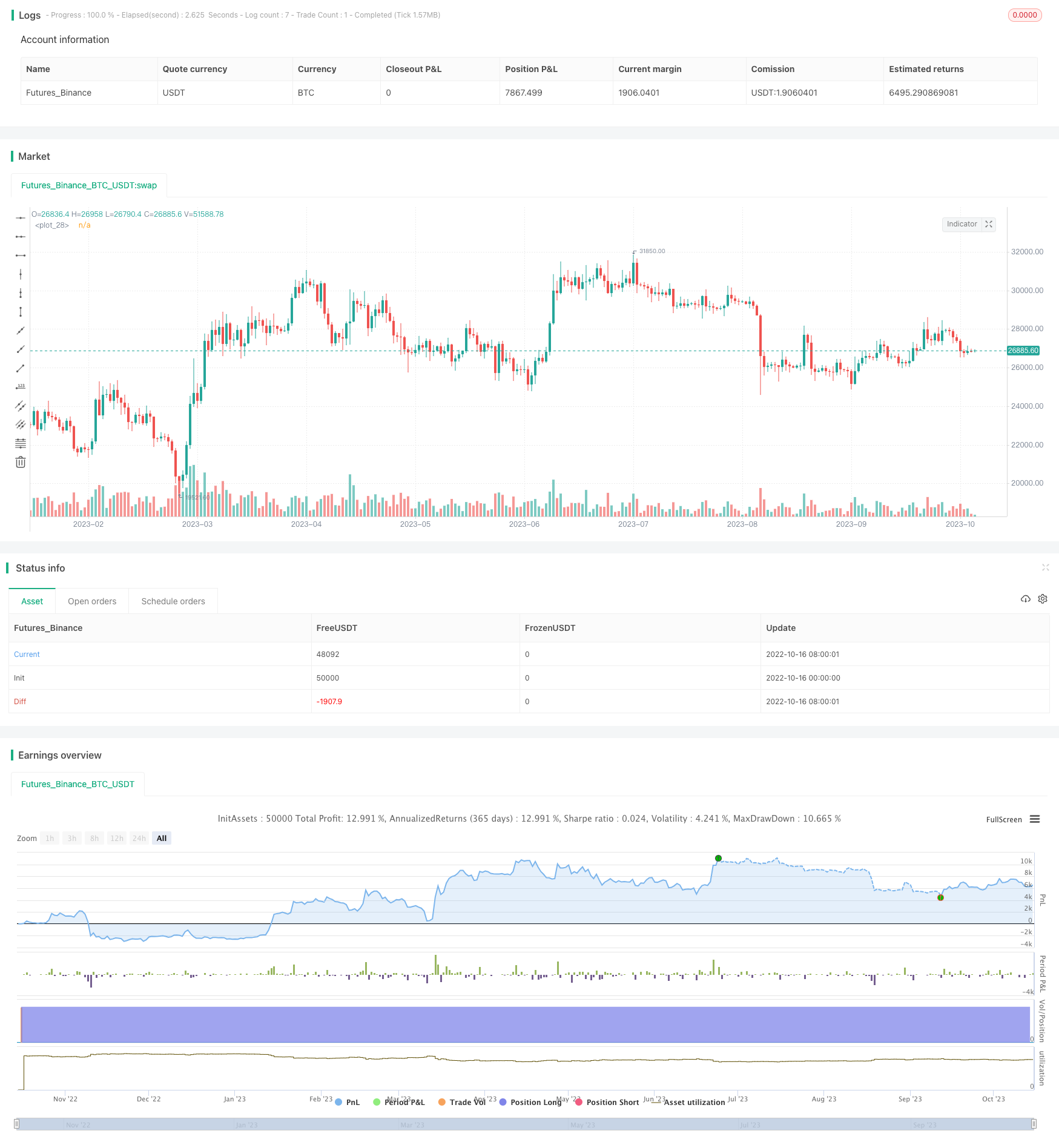
概述
本策略运用假设检验的方法判断ATR是否偏离均值,结合对价格走势的预测,实现了一个基于ATR的均值回复交易策略。当ATR出现显著偏离时,表明市场可能存在反常波动。此时,如果价格走势预测为看涨,则可以建立做多头寸。
策略原理
假设检验
快速ATR周期(参数atr_fast)与慢速ATR周期(参数atr_slow)进行两样本t检验。假设检验的零假设H0为两样本均值无显著差异。
如果检验统计量高于阈值(参数reliability_factor指定的置信区间),则拒绝原假设,即认为快速ATR已明显偏离慢速ATR。
价格走势预测
计算对数收益率的移动平均作为预期漂移率(参数drift)。
如果漂移率上升,则判断目前为看涨趋势。
入场及止损退出
当快慢ATR差异显著且趋势看涨时,做多入场。
随后利用ATR计算持续调整止损线。当价格跌破止损线时止损退出。
优势分析
利用假设检验判断ATR异常偏离更科学、参数自适应。
结合价格趋势预测,避免了仅凭ATR偏离做出错误交易。
持续调整止损,降低亏损风险。
风险分析
价格出现断崖式下跌时,无法止损。
趋势判断存在错误,可能买入最高点。
参数设置不当,将错过正确的交易时点或者增加不必要的交易。
优化建议
可考虑加入其它指标进行多因子确认,避免单一指标造成错误交易。
可以测试不同的ATR参数组合,找到更稳定的参数。
增加对突破关键价格关口的判断,避免买入假突破。
总结
本策略总体思路清晰,利用假设检验判断反常波动的思路可取。但ATR偏离并不能完全判断趋势,需增加判断依据提高准确性。止损规则可靠,但无法应对断崖式下跌。未来可从入场条件、参数选择、止损优化等方面进行改进。
策略源码
/*backtest
start: 2022-10-16 00:00:00
end: 2023-10-16 00:00:00
period: 1d
basePeriod: 1h
exchanges: [{"eid":"Futures_Binance","currency":"BTC_USDT"}]
*/
// This source code is subject to the terms of the Mozilla Public License 2.0 at https://mozilla.org/MPL/2.0/
// © DojiEmoji
//@version=5
strategy("Mean Reversion (ATR) Strategy v2 [KL] ", overlay=true, pyramiding=1)
var string ENUM_LONG = "Long"
var string GROUP_TEST = "Hypothesis testing"
var string GROUP_TSL = "Stop loss"
var string GROUP_TREND = "Trend prediction"
backtest_timeframe_start = input(defval=timestamp("01 Apr 2000 13:30 +0000"), title="Backtest Start Time")
within_timeframe = true
// TSL: calculate the stop loss price. {
ATR_TSL = ta.atr(input(14, title="Length of ATR for trailing stop loss", group=GROUP_TSL)) * input(2.0, title="ATR Multiplier for trailing stop loss", group=GROUP_TSL)
TSL_source = low
TSL_line_color = color.green
TSL_transp = 100
var stop_loss_price = float(0)
if strategy.position_size == 0 or not within_timeframe
TSL_line_color := color.black
stop_loss_price := TSL_source - ATR_TSL
else if strategy.position_size > 0
stop_loss_price := math.max(stop_loss_price, TSL_source - ATR_TSL)
TSL_transp := 0
plot(stop_loss_price, color=color.new(TSL_line_color, TSL_transp))
// } end of "TSL" block
// Entry variables {
// ATR diversion test via Hypothesis testing (2-tailed):
// H0 : atr_fast equals atr_slow
// Ha : reject H0 if z_stat is above critical value, say reliability factor of 1.96 for a 95% confidence interval
len_fast = input(14,title="Length of ATR (fast) for diversion test", group=GROUP_TEST)
atr_fast = ta.atr(len_fast)
std_error = ta.stdev(ta.tr, len_fast) / math.pow(len_fast, 0.5) // Standard Error (SE) = std / sq root(sample size)
atr_slow = ta.atr(input(28,title="Length of ATR (slow) for diversion test", group=GROUP_TEST))
test_stat = (atr_fast - atr_slow) / std_error
reject_H0 = math.abs(test_stat) > input.float(1.645,title="Reliability factor", tooltip="Strategy uses 2-tailed test; Confidence Interval = Point Estimate (avg ATR) +/- Reliability Factor x Standard Error; i.e use 1.645 for a 90% confidence interval", group=GROUP_TEST)
// main entry signal, subject to confirmation(s), gets passed onto the next bar
var _signal_diverted_ATR = false
if not _signal_diverted_ATR
_signal_diverted_ATR := reject_H0
// confirmation: trend prediction; based on expected lognormal returns
_prcntge_chng = math.log(close / close[1])
// Expected return (drift) = average percentage change + half variance over the lookback period
len_drift = input(14, title="Length of drift", group=GROUP_TREND)
_drift = ta.sma(_prcntge_chng, len_drift) - math.pow(ta.stdev(_prcntge_chng, len_drift), 2) * 0.5
_signal_uptrend = _drift > _drift[1]
entry_signal_all = _signal_diverted_ATR and _signal_uptrend // main signal + confirmations
// } end of "Entry variables" block
// MAIN {
// Update the stop limit if strategy holds a position
if strategy.position_size > 0 and ta.change(stop_loss_price)
strategy.exit(ENUM_LONG, comment="sl", stop=stop_loss_price)
// Entry
if within_timeframe and entry_signal_all
strategy.entry(ENUM_LONG, strategy.long, comment=strategy.position_size > 0 ? "adding" : "initial")
// Alerts
_atr = ta.atr(14)
alert_helper(msg) =>
prefix = "[" + syminfo.root + "] "
suffix = "(P=" + str.tostring(close, "#.##") + "; atr=" + str.tostring(_atr, "#.##") + ")"
alert(str.tostring(prefix) + str.tostring(msg) + str.tostring(suffix), alert.freq_once_per_bar)
if strategy.position_size > 0 and ta.change(strategy.position_size)
if strategy.position_size > strategy.position_size[1]
alert_helper("BUY")
else if strategy.position_size < strategy.position_size[1]
alert_helper("SELL")
// Clean up - set the variables back to default values once no longer in use
if strategy.position_size == 0
stop_loss_price := float(0)
if ta.change(strategy.position_size)
_signal_diverted_ATR := false
// } end of MAIN block